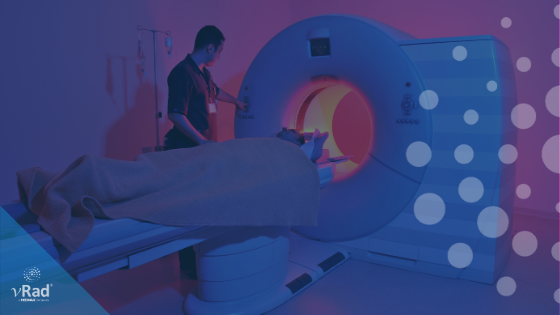A Post-COVID Radiologist Job Market, and What You Should Know
The 2021 radiologist job market finds radiologists at the mercy of those who would hire them. The imbalance has a lot to do with a certain public...

Remote radiologist jobs with flexible schedules, equitable pay, and the most advanced reading platform. Discover teleradiology at vRad.

Radiologist well-being matters. Explore how vRad takes action to prevent burnout with expert-led, confidential support through our partnership with VITAL WorkLife. Helping radiologists thrive.

Visit the vRad Blog for radiologist experiences at vRad, career resources, and more.

vRad provides radiology residents and fellows free radiology education resources for ABR boards, noon lectures, and CME.

Teleradiology services leader since 2001. See how vRad AI is helping deliver faster, higher-quality care for 50,000+ critical patients each year.

Subspecialist care for the women in your community. 48-hour screenings. 1-hour diagnostics. Comprehensive compliance and inspection support.

vRad’s stroke protocol auto-assigns stroke cases to the top of all available radiologists’ worklists, with requirements to be read next.

vRad’s unique teleradiology workflow for trauma studies delivers consistently fast turnaround times—even during periods of high volume.

vRad’s Operations Center is the central hub that ensures imaging studies and communications are handled efficiently and swiftly.

vRad is delivering faster radiology turnaround times for 40,000+ critical patients annually, using four unique strategies, including AI.
.jpg?width=1024&height=576&name=vRad-High-Quality-Patient-Care-1024x576%20(1).jpg)
vRad is developing and using AI to improve radiology quality assurance and reduce medical malpractice risk.

Now you can power your practice with the same fully integrated technology and support ecosystem we use. The vRad Platform.

Since developing and launching our first model in 2015, vRad has been at the forefront of AI in radiology.

Since 2010, vRad Radiology Education has provided high-quality radiology CME. Open to all radiologists, these 15-minute online modules are a convenient way to stay up to date on practical radiology topics.

Join vRad’s annual spring CME conference featuring top speakers and practical radiology topics.

vRad provides radiology residents and fellows free radiology education resources for ABR boards, noon lectures, and CME.

Academically oriented radiologists love practicing at vRad too. Check out the research published by vRad radiologists and team members.

Learn how vRad revolutionized radiology and has been at the forefront of innovation since 2001.

%20(2).jpg?width=1008&height=755&name=Copy%20of%20Mega%20Nav%20Images%202025%20(1008%20x%20755%20px)%20(2).jpg)

Visit the vRad blog for radiologist experiences at vRad, career resources, and more.


Explore our practice’s reading platform, breast imaging program, AI, and more. Plus, hear from vRad radiologists about what it’s like to practice at vRad.

Ready to be part of something meaningful? Explore team member careers at vRad.

Teleradiology plays an important role in improving the standard of care for patients who have the unfortunate circumstance of having their illness present at times when physicians, nurses and hospitals are not always at their best and/or most fully staffed. It has long been known that the standard of care maintained by a hospital at 2 p.m. is not the same standard that is seen at 2 a.m. And, why is that? Why in this day and age with our level of technology and high levels of training does this persist?
Off-Hours Care in Stroke Centers
A Reuters Health article discussing this issue focused on stroke and stroke imaging centers. They found there was a slight increase in the risk of death for those coming to the hospital on the weekend or holidays versus weekdays, 17.2 percent versus 16.5 percent. In numbers, if the same weekday death rate prevailed in the off-hours group, about 259 patients died simply because they did not have the foresight to get sick on a weekday. Some might say that is not many, overall. Two hundred, fifty-nine out of about 37,000; but when that is broken into potentially unnecessary deaths of mothers, fathers, brothers and sisters, the number is inexcusable. And remember, this is looking at only one small area of care.
Hospitals designated as primary or comprehensive stroke centers provide the best possible care for stroke patients, regardless of the hour or day of presentation; but not every hospital can be a stroke center. So, what about the much larger group of hospitals in the U.S. that treat stroke patients who are not now or never will qualify as stroke centers? I believe, the radiologists at vRad and executive team at vRad believe this is where teleradiology has a huge role to play.
Telemedicine and Stroke Care
Heartland Regional Medical Center in St. Joseph, MO, a long time client of vRad (previously NightHawk Radiology Services) recently stepped up their level of care by becoming the first non-Mayo system hospital to take advantage of the stroke telemedicine care. Mayo Clinic neurologists now have the credentials and ability to practice stroke neurology at Heartland. This addition, along with vRad’s unwavering commitment to supporting this medical center and hundreds of others like it, has the best opportunity to bring their 24/7/365 standard of care up to that typically seen only at the best comprehensive stroke centers in the country. Perry Kaneriya, M.D., a subspecialist neuroradiologist with vRad since 2008, says, “…teleradiology has improved the quality of stroke diagnosis and treatment at hospitals throughout the country. The time of day and proximity to major medical centers no longer determine the quality of neurologic diagnostic services."
Teleradiology Improves Turnaround Times
Teleradiology and telemedicine together are supporting improvements in the level of patient care not otherwise possible in places where many times the needs are greatest. This is not to say we do not work with many primary and comprehensive stroke centers, we most certainly do. However, we also feel a tremendous responsibility to help bring an improved standard of care to every patient we can by working with large and small hospitals across the U.S., in all 50 states. Laura Hotchkiss, M.D., a radiologist with vRad since 2009 says, “As a radiologist who worked in hospital settings for 25 years, I can state that turnaround time for a stroke protocol, especially in a critical access hospital, is far more likely to be faster with teleradiology.” Those who constantly complain about and criticize teleradiology and telemedicine, many times without a real alternative, would do well to remember the role teleradiology plays in the lives of these real people.
Telemedicine Raises the Standard of Care
Teleradiology and telemedicine are making a difference. By improving, enhancing and using the right technology, our radiologists are working with our clinical colleagues and partners to forge a new standard of care. It’s a standard that can be maintained throughout the night, on weekends and holidays, and a standard of care that brings subspecialists and their training to bear any time and every time a patient needs the best care our radiologists and technology can provide.
vRad. Radiology excellence delivered! Together! – Not just a clever slogan, something our patients can depend on.
Back to Blog.png)
The 2021 radiologist job market finds radiologists at the mercy of those who would hire them. The imbalance has a lot to do with a certain public...

The demand for imaging studies is expected to continue to increase for the foreseeable future. However, the number of radiologists on hand to perform...
.png)
1 min read
For the latest information on vRad’s Artificial Intelligence program please visit vrad.com/radiology-services/radiology-ai/ Originally...
vRad (Virtual Radiologic) is a national radiology practice combining clinical excellence with cutting-edge technology development. Each year, we bring exceptional radiology care to millions of patients and empower healthcare providers with technology-driven solutions.
Non-Clinical Inquiries (Total Free):
800.737.0610
Outside U.S.:
011.1.952.595.1111
3600 Minnesota Drive, Suite 800
Edina, MN 55435